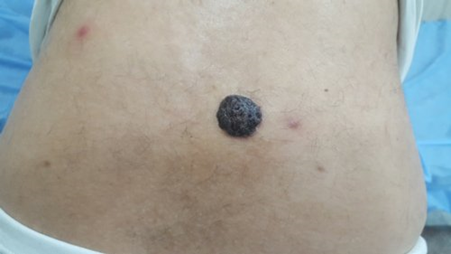ABCDE Rule
Clinical Assessment of a Lesion

Figure 6: Large, unusual mole
- You assess this photograph according to the ABCDE criteria, a very useful system for examining most skin lesions
Click each of letters of the mnemonic to reveal the assessment:
A is for Asymmetry
- A seborrheic keratosis is usually (but not always) symmetrical, whereas melanoma is often irregular or asymmetrical in shape and/or colour
- In this case you can clearly see the lesion is symmetrical
B is for Border irregularity
- A typical seborrheic keratosis has well defined, regular borders, whereas a melanoma often has irregular, blurry, or jagged edges and hard-to-define border
- In this case you can clearly see the photograph shows a lesion with a regular, well-defined border
C is for Colour variability and/or Changing colour
- Seborrheic Keratoses have a highly variable appearance in terms of colour - they can be skin coloured, yellow, grey, light brown, dark brown, black or mixed colours
- Where they appear to be >2 different mixed colours, this can raise suspicion of malignancy
- However, you can clearly see a uniform dark brown colour in the photograph the patient has submitted
D is for Different
- A typical seborrheic keratosis looks different to a mole in that it often has a waxy or warty "stuck on" appearance
- A pigmented lesion that is obviously different from the others is sometimes called an 'ugly duckling', 'black sheep', 'lone ranger', or 'odd-mole-out' and must be considered suspicious even if it does not fulfil the ABCDE criteria
- Comparing this lesion to the patient's other moles is something that may be useful if you were seeing this patient face-to-face
- However, based on the warty appearance seen in the image sent by the patient, this is suggestive of seborrheic keratosis
E is for Evolving (changing)
- A benign mole is usually stable and does not change in size, shape, or colour, whereas a melanoma changes over time
- Change in size, colour, shape, or structure may be noted over months to years
- In this case the patient is telling you he has had this lesion for a few years and has not noted any changes hence the lack of change is less concerning
